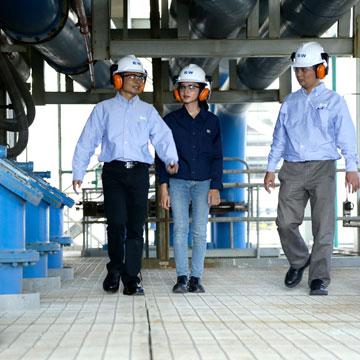شركة Babcock & Wilcox موجودة لتتعاون في مجال التركيز الوحيد الذي يساعد العملاء على خلق طاقة أنظف. نقوم بهذا من خلال تقنيات إزالة الكربون التي أثبتت جدواها والابتكارات في مجال توليد الطاقة والتحكم في الانبعاثات. شركة B&W شركة رائدة ومبتكرة ومؤيدة للحد من غازات الاحتباس الحراري. نقوم بذلك في ثلاثة قطاعات ذات صلة:
التغير على عالمنا لأكثر من 150 عامًا
شركة Babcock & Wilcox . الأصلية، التي تأسست عام 1867، قمنا بإضفاء التغير على عالمنا لأكثر من 150 عامًا
بدأت شركة Babcock & Wilcox (B&W) في عام 1867 ببراءة اختراع واحدة وصديقين والتزام لا يتزعزع تجاه الابتكار الموثوق والفعال. عندما أعلن ستيفن ويلكوكس لأول مرة أنه "يجب أن تكون هناك طريقة أفضل" لتوليد الطاقة بأمان، استجاب هو وجورج بابكوك بتصميم أول غلاية أنابيب مياه آمنة بطبيعتها، ووُلدت الشركة. هذا التحدي للتحسن المستمر قائم اليوم.
لقد نمونا في مختلف الصناعات والقارات. لقد قمنا بتنويع الأدوات التي نستخدمها والتقنيات التي نقدمها. هناك شيء واحد لم يتغير ولن يتغير أبدًا هو التزامنا بهندسة طريقة أفضل. هذه هي الطريقة التي نضفي بها التغيير على عالمنا.
إزالة الكربون من أجل مستقبل صفري صافٍ
اليوم، نطور تقنيات جديدة لانتقال الطاقة الناشئ والمستمر.
العالم يريد أفعالاً. التزمت أكثر من 100 دولة بتحقيق هدف الصفر الصافي للانبعاثات الكربونية بحلول منتصف هذا القرن. لقد مر ما يقرب من نصف تلك السنوات، ولذا لا يمكننا أن نرتاح.
حصلت شركة Babcock & Wilcox على أكثر من 90 براءة اختراع لرصد الكربون على مدار العقود الأربعة الماضية، وكانت رائدة في البحث والتطوير في مجال إزالة الكربون. يمكن لتقنيتنا الثورية لإزالة الكربون ClimateBright™ أن تفصل ثاني أكسيد الكربون بشكل فعال مع إنتاج الهيدروجين و/أو البخار و/أو غاز الاصطناع - ولها تطبيقات في مجموعة من الصناعات بما في ذلك إنتاج الطاقة وتصنيع الأغذية والصلب والأسمنت والنفط والغاز والأدوية والبتروكيماويات وأسود الكربون، ولباب الورق والورق. دعونا نتعاون لإزالة الكربون.

خدمات ما بعد البيع الذكية
B&W لأصعب تحديات عملائنا وتحلها. بدءًا من الفكرة والتكليف وحتى الصيانة والتعديلات، نحن في كل خطوة على الطريق للحفاظ على معداتك تعمل بأمان وموثوقية وكفاءة بغض النظر عن جهة التصنيع الأصلية..
- ترقيات المكونات والنظام والتعديلات التحديثية
- تقييم حالة المعدات
- مراجعات الكفاءة
- استكشاف أخطاء الأداء والمعدات وإصلاحها
- خدمات الهندسة الميدانية
- الدعم في حالة الانقطاع
- الاستبدال وقطع الغيار
- بدء التشغيل والدخول للخدمة
- الصيانة الروتينية والوقائية



